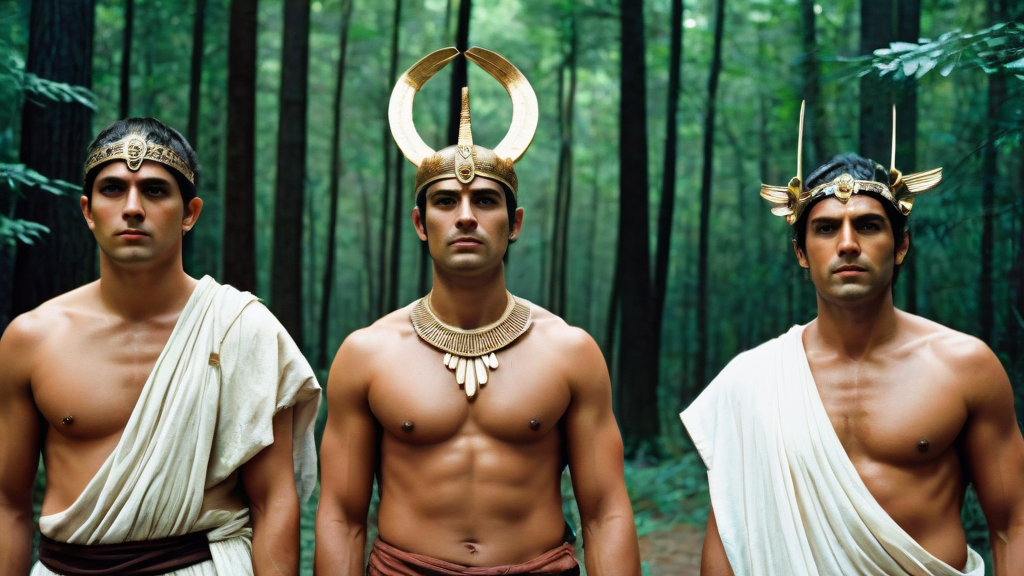
Throughout history, human civilizations have revered various deities associated with nature and vegetation, embodying the spirit of the natural world and protecting its realms. These divine beings represent the cycle of life, growth, and renewal, offering guidance and blessings to those who honor them. Their stories are so fascinating and we frequently use nature deities to inspire our bath and body products. Let’s delve into the fascinating realm of 10 of the most popular nature and vegetation deities, each with their unique histories and domains.
1. The Horned God:
The Horned God is a symbol of masculine energy and fertility, often depicted with antlers or horns. In pagan traditions, he represents the wild and untamed aspects of nature, ruling over forests, animals, and the hunt. Associated with the changing seasons, the Horned God transitions from the youthful vitality of spring to the wisdom of winter. He is revered as a protector of wildlife and guardian of the wilderness.
2. The Green Man:
The Green Man is a symbol of rebirth, growth, and the cycle of life. Found in various cultures across the world, he is often depicted with a face surrounded by foliage or as a figure emerging from leaves and vines. As a guardian of the forest and vegetation, the Green Man embodies the vitality and abundance of nature. He symbolizes the interconnectedness of all living things and reminds us of the importance of conservation and sustainability.
3. Pan:
Pan, the Greek god of shepherds, forests, and rustic music, is often depicted as a half-man, half-goat figure playing his pan flute amidst nature. He embodies the wild and primal forces of the wilderness, inspiring both fear and reverence among ancient Greeks. Pan’s realm includes mountainous landscapes, woodlands, and remote wilderness areas where he roams freely. He symbolizes the untamed spirit of nature and the raw power of the wild.

4. Demeter:
Demeter, the Greek goddess of agriculture, fertility, and the harvest, is revered as a protector of crops and vegetation. Associated with the bountiful earth, she oversees the cycle of planting, growth, and harvest, ensuring abundance and prosperity for humanity. Demeter’s realm includes fields, orchards, and cultivated lands, where her blessings ensure the fertility of the soil and the success of agricultural endeavors.
5. Cernunnos:
Cernunnos, the Celtic god of fertility, animals, and the underworld, is depicted as a horned figure often associated with the stag, a symbol of virility and strength. Revered by ancient Celts, he embodies the vitality and regenerative power of nature, ruling over forests, wild animals, and the mysteries of life and death. Cernunnos is a guardian of the wild places, guiding hunters and protecting the balance of the natural world.
6. Artemis:
Artemis, the Greek goddess of the hunt, wilderness, and childbirth, is revered as a protector of wildlife and guardian of the forest. Known for her fierce independence and connection to nature, she roams the woodlands with her bow and arrow, safeguarding animals and preserving the sanctity of the wilderness. Artemis symbolizes the untamed beauty of the natural world and the importance of conservation and habitat preservation.
7. Gaia:
Gaia, the Greek primordial goddess of the earth, embodies the nurturing and life-sustaining aspects of nature. Revered as the mother of all living things, she governs the fertile soil, flowing rivers, and lush vegetation that sustain life on earth. Gaia symbolizes the interconnectedness of all living beings and the sacredness of the natural world. She reminds humanity of their responsibility to protect and honor the earth.
8. Freyr:
Freyr, the Norse god of fertility, prosperity, and sunshine, is revered as a bringer of abundance and blessings to the land. Associated with agriculture and the fertility of the earth, he ensures the success of crops and the prosperity of farmers. Freyr’s realm includes fields, meadows, and agricultural landscapes where his presence brings forth growth and vitality. He symbolizes the fecundity and generosity of the natural world.
9. Hathor:
Hathor, the Egyptian goddess of love, beauty, and music, is also revered as a deity of fertility and vegetation. Associated with the nourishing waters of the Nile River, she ensures the fertility of the land and the abundance of crops. Hathor’s realm includes fertile valleys, lush oases, and agricultural lands where her blessings bring forth growth and prosperity. She symbolizes the life-giving power of water and the bountiful gifts of the earth.
10. Dionysus:
Dionysus, the Greek god of wine, ecstasy, and fertility, is revered as a patron of vineyards, orchards, and the grape harvest. Known for his wild and ecstatic celebrations, he embodies the joyous abundance of nature and the intoxicating power of the earth’s bounty. Dionysus’s realm includes vineyards, forests, and mountainous regions where his presence inspires revelry and celebration. He symbolizes the inherent connection between humanity and the natural world.
Nature and vegetation deities hold a special place in human culture, embodying the spirit of the natural world and protecting its realms. Whether as guardians of the forest, patrons of agriculture, or symbols of fertility and abundance, these divine beings inspire reverence and awe among those who honor them. As we reconnect with the rhythms of nature and cultivate a deeper appreciation for the earth’s beauty, may we also honor and respect the deities who embody its sacred essence.
